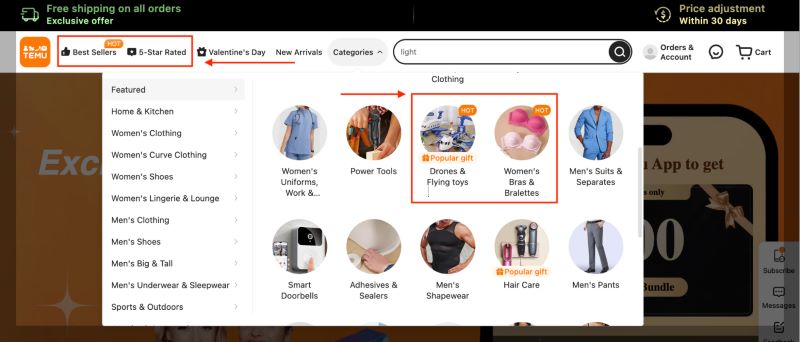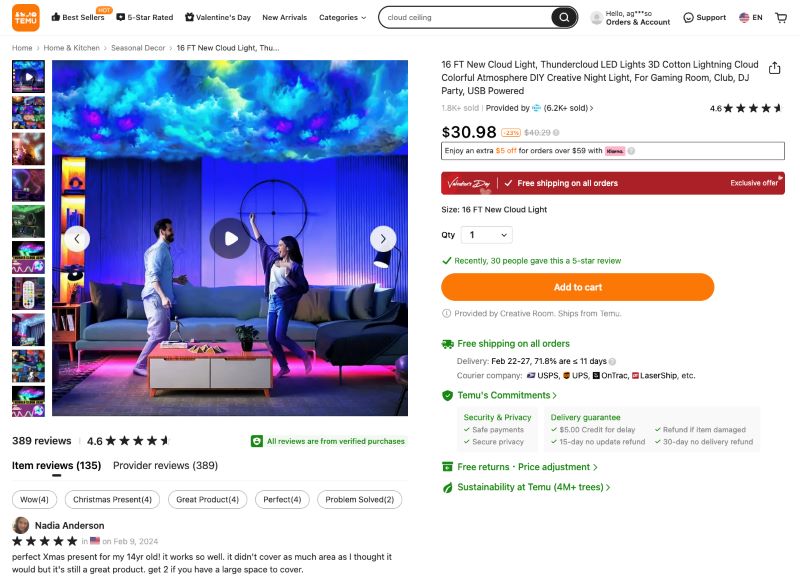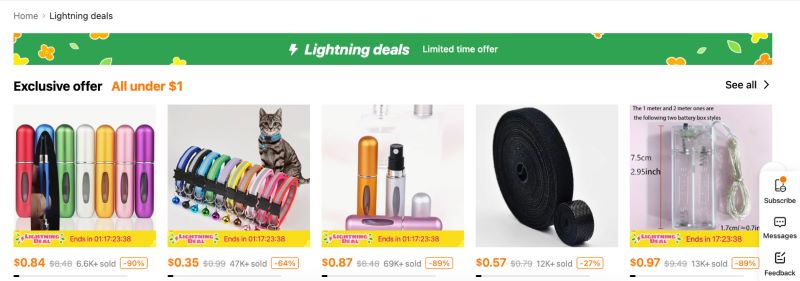Temu is an ecommerce marketplace that carries a huge potential for sourcing items for reselling. It offers very low factory-direct prices, huge discounts, price adjustment guarantees, a generous return policy, and more.
To resell Temu products, decide where to sell first. Then, find products for reselling, determine pricing, purchase initial inventory, and set up listings. Once all is set, you can start promoting and selling.
Key Takeaways:
- Temu is making waves because of its competitive factory pricing, generous 90-day free returns, and marketing efforts including multiple Super Bowl ads.
- Temu has a wide range of low-cost products that can potentially be resold for a profit.
- Note that some items may be counterfeit and/or low quality; diligent research is required.
- Market research and competitive pricing are key to a successful reselling venture.
Follow our step-by-step guide below to get started reselling Temu products.
Step 1: Decide Where to Sell Your Products
The first step in reselling items on Temu is to decide where to sell your products. Whether you want to sell in-person or online, look into the costs involved and research locations and platforms.
There are plenty of channels to sell your items from Temu. Consider the following:
- Your Own Online Store: To start your online store, you need an ecommerce platform. It is recommended to have your own store when selling online as it gives you full control over how your shop looks. You can also integrate other selling platforms into your chosen platform. Learn more about the costs involved in building your online store and read our top picks for best ecommerce platforms.
- Online Marketplaces: While marketplaces don’t give you much room for customizing your store, you have access to a built-in audience that gives you an advantage especially when you are a new seller. Amazon is a popular marketplace for reselling Temu products.
- Social Media: Social commerce is trending these days, and TikTok is at the forefront of it all, especially with the launch of TikTok Shop in the US. Also, consider selling Temu items on Facebook and Facebook Marketplace.
- Local In-person, Kiosks, and Pop-Up Shops: Brick-and-mortar stores require more investment upfront but can be a great way to build your brand’s credibility. Also consider opening shoppable kiosks or test the waters by opening a pop-up shop.
Step 2: Find Products to Resell
Once you decide where to sell products, the next step is to find quality products on Temu fit for reselling. There are a couple of ways to do this, but be ready to do plenty of research.
Go for Product Categories With Top-selling Items
These categories usually give you an idea of trending and in-demand products on the platform. Some top-performing categories on Temu are:
- Electronics: Mobile accessories, smartwatches, creator accessories
- Home & Garden: Home décor, home improvement tools, kitchen gadgets
- Beauty & Health: Makeup tools; nail and hair accessories
- Fashion: Clothing, bags, jewelry
- Toys & Baby Products: Baby accessories, preschool toys
- Sports & Outdoors: Fitness equipment
Use Temu’s Built-in Filters
Temu’s built-in filters make product search and discovery more efficient. You can identify which items are the best-sellers in a product category.
From the homepage, you can click on the Best Sellers and 5-Star Rated options on the navigation menu to see the most popular products. Alternatively, you can click on the Categories dropdown menu, choose a product category, and scroll through some of the featured products. Best-selling items are labeled “HOT!” and “Popular gift.”

After scrolling through products you are interested in, gather a shortlist for the next step.
Analyze Your Shortlisted Products in Detail
Assess them based on selling metrics and trends. There are a few ways to check this on the Temu platform.
Look for a product’s details, like:
- Number of buyer reviews: This number indicates interest and sales, and consistently high numbers suggest that a product is evergreen.
- Buyer ratings: High average ratings coupled with a high number of reviews confirm popular and high-quality products.
- Number of orders: This number indicates strong consumer demand.
You can check for the number of buyer reviews and buyer ratings by going to the product page and scrolling down, like how it looks below.

You can check for the number of orders beside a product’s price on the product search page, like those highlighted in the image below.

Check the seller too. Look at the following:
- Number of followers: Popular (and reliable) sellers usually have a high following. This speaks of their quality of service and products.
- Seller Details: Do the top sellers have Best Seller badges? This demonstrates their success with the product.
Take a look at this Temu seller below. You can check its follower count, the number of repeat customers, and read buyer reviews.

Validate Your Product Research
Product validation is an integral part of doing product research because this is where you can confirm if the product will be profitable or not. You can use external tools for insight into competition, pricing, and demand, and look into popular marketplaces for comparison.
Using External Tools
To validate your product choices, you can use the following external tools:
- Confirm search volume and product demand using keyword research tools such as Google Trends, Keyword Planner, and SEMRush. High numbers indicate strong consumer interest.
- Use ecommerce market intelligence tools like Google Shopping Insights and Jungle Scout. These tools give insights into competition, average pricing, and more.
Product Research for Amazon
Amazon is a popular choice for reselling Temu items, so it’s best to know more details about pricing items on Amazon. To validate products for selling on Amazon, we recommend doing the following:
- Go to the Amazon Best Sellers list. It is an excellent place to start product research. Browse per category and explore rising trends and new releases. Keep an eye out for generic items that are popular but not tied to a specific brand.
- As you look at possible products to resell, take note of details like ship weight, sturdiness, category popularity, competition, wholesale price, and shipping costs. These help gauge your profit since you will also know the overhead costs you will be incurring.
- Read Amazon reviews. These are helpful resources for gauging consumer interest and identifying market gaps.
- Utilize several tools to determine a product’s profitability. For example, we used Salecalc to calculate potential net profit and margin on our article on recommended products to sell on Amazon—it’s free. Other paid tools like Jungle Scout and Sellics have additional features that help calculate and manage Amazon sales.
Product Research on TikTok
TikTok is another popular selling place for Temu resell items. TikTok heavily relies on virality, so validate your product research by checking the platform’s data from the TikTok Creative Center. To check on trending products, spend some time going through your For You Page feeds.
Step 3: Determine Pricing
After you have decided which products to resell, the next step would be to determine pricing. A big advantage of finding resell items on Temu is their incredibly low pricing. This sets you up for a sizable profit if you plan strategically.
- Compare product pricing variation on the Temu platform. Popular items usually are offered by multiple sellers, so analyze pricing between sellers, their offered discounts, and get the ideal price range to maximize profits.
- Compare prices against other retailers outside Temu. Utilize price comparison sites to know the typical pricing ranges for online and retail stores of your chosen product. A wider price gap means you have more room for profit on resale.
The following guides have pricing calculators and strategies that can help you set pricing for your products:
- How to Price a Product (+ Profit Calculators)
- Retail Markup Calculator: How to Price Your Products
- Pricing Strategies (+ Examples)
- What Is Dynamic Pricing? Types, Examples & Benefits
Step 4: Purchase Inventory
The next step is purchasing your initial inventory for selling. Ideally, you should order sample quantities to be able to check the products in person. If this is not possible, set an initial inventory that will allow you to get your return on investment in the quickest possible time with the lowest risk of loss.
Before ordering, make sure to:
- Factor in your shipping costs. Bulky, heavy, or fragile items have higher shipping expenses and reduce profit margins. Make sure to add up your total landed costs before purchasing inventory.
- Verify the seller’s return policy and warranty. Temu has a generous return policy—up to 90 days. Also, there’s buyer protection in place that lets you secure the sale price for an item you previously purchased before a sale as long as it’s within a 30-day window. Simply put, if a seller decides to reduce product prices within a month of your purchase, you can recoup a portion of your money based on the sale difference. It is best to confirm these with the seller before placing an order.
Fortunately, there are also some tips to be able to further save on purchasing your items for reselling on Temu. You can order items using coupons and bulk discounts to maximize profit margins.
- Check Flash Deals. There are daily flash sales called Lightning Deals that offer special discounts on select items for 24 hours.
- Use Coupons. Temu provides sitewide and category-specific promo codes, along with new user coupons for extra savings to maximize margins.

Keep an eye out for lightning deals on Temu to maximize profit margins when purchasing items for reselling.
Inventory can be tricky, but you can learn more by reading our following guides:
- Retail Inventory Management: Definition & Best Practices
- Free Inventory Templates + Instructions
- Safety Stock Definition & Calculator for Retailers
- Inventory Carrying Cost: Calculator, Formula & Reduction Tips
Step 5: Set Up Product Listings
Once you receive your products, it’s time to create your product listings so you can get started on selling. Before doing so, carefully inspect all items. Clean, replace packaging if necessary, and photograph your products.
This goes without saying, but write compelling product descriptions, use captivating images, and upload product videos if you can. If you are a small business owner, these tasks can be daunting, especially if you are a one-man or small team. Consider using AI to write product descriptions to save time and money.
See more:
- How to Write a Product Description [+ Template & Examples]
- How to Take Product Photos at Home
- How to Create a Product Video Shoppers Will Love (for Free)
Step 6: Sell & Promote
After you have created your product listings and assuming you are done setting up your store, it is time to sell!
Promotion can be done in a variety of ways, but if it’s your first time selling online, it is crucial to get the word out and let people know that your store is open. We recommend crafting your marketing strategy based on the platform you choose to sell on.
- If you are intent on selling on TikTok, promotion and marketing will need to be catered to creating unique, authentic, and entertaining content to ensure your videos gain traction and get featured more on For You page feeds. Staying on top of TikTok trends and leveraging user-generated content are also crucial marketing tactics. Read more about our recommended TikTok ecommerce strategy guide.
- Search engine optimization (SEO) is a tried-and-tested way to increase visibility in search engines. Use product keywords strategically. Learn more about SEO for ecommerce.
- If you are selling on Amazon, its search engine has its own algorithm. It prioritizes listings most likely to generate a sale from the shopper searching. So your SEO strategy should be customer-focused. Your listings should be clear and attractive to potential buyers. Learn more about how to rank well on Amazon with Amazon SEO.
- Make a concentrated effort to build your store’s email list too. Email marketing is still one the best and proven ways to nurture customer relationships—letting you retain more of them and increase sales.
See also: Ecommerce Marketing Strategy Ideas for Retailers
If you plan to sell in-person, either via a pop-up, a temporary kiosk, or a storefront, here are some retail marketing strategies you can implement:
- Retail Marketing Strategy Ideas to Drive Sales
- Retail Mobile Marketing: Creating a Strategy to Drive In-store Sales
- Effective POS Marketing Ideas for Driving Sales
Frequently Asked Questions (FAQs)
Click the tabs below to get answers from the most frequently asked questions about reselling Temu products.
Yes, you can buy products on Temu and resell them for profit.
Yes, it is possible to earn profit from reselling Temu products especially if you are strategic when it comes to pricing and marketing. Market research, competitive pricing, and effective marketing are needed to ensure profitability.
It is easy to become a Temu reseller. Temu doesn’t require accreditation. You can just buy items in bulk and resell them on your chosen platform.
Bottom Line
Reselling Temu products is a great way to start selling online because of its low prices, generous return policy, and free shipping for small items. To resell Temu products, do some research on the platforms you want to sell on first. Most of your time will be centered on finding and sourcing products for reselling. By following the steps above along with our tips, you can start your business reselling Temu products soon.